SPECIAL TOOL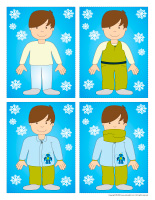
This special tool was created in response to a special request. (Open Getting dressed for winter routine) Print, laminate, and display in your cloakroom or near your daycare entrance. Encourage children to place the steps in the correct order as they practice getting dressed.
CIRCLE TIME
Animated discussion-Snowflakes
(Open picture game-Snowflakes) Print and laminate the pictures in the format you prefer. Use them to spark a conversation with your group. Ask them questions to see what they know about the theme.
Make a snowflake hat
Find an old hat and have children glue plastic or Fun Foam snowflakes all over it.
Hidden snowflakes
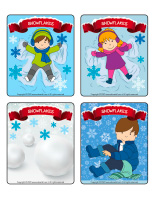
Hide several snowflakes throughout your daycare. Invite children to search for them and set them in the centre of the table (or your circle time area). Use them to spark a conversation with your group.
I can talk about snowflakes…with a puppet
Use a puppet to encourage children to talk about different subjects related to the theme. The puppet may help children who are shy participate in circle time discussions. What’s more, it can help children who require language support. One thing is certain : the puppet will foster language development.
Clothesline
Have children cut out pictures and illustrations of winter clothes. Provide clothespins they can use to hang the items on an indoor clothesline. This activity can last all week.
Poni discovers and presents-Winter
(Open Poni discovers and presents-Winter) Print and laminate the cards. Cut them out. Use a Poni puppet or another puppet children are familiar with to present the various winter-themed pictures to your group.
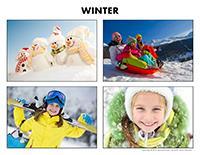
Winter thematic bin: white sheets, Styrofoam balls, winter illustrations, thematic books, boots, mittens, scarves, shovels, winter figurines, polar animals, fishing rod, white tissue paper, artificial snow, cotton balls, white paint, white modeling dough, sugar, flour, salt, rice, popcorn, etc.
Snowflakes
Sit in a circle in front of a large window and watch snowflakes fall from the sky. Discuss their color and shape. Describe the way they are falling and identify different activities that can be enjoyed after a snowfall.
Wall of seasons
(Open poster-Seasons) Print. Ask parents to provide a few pictures they took outside and use them to create a “Wall of seasons”. Divide your wall into four sections and display one of the posters in each section. Invite children to associate each of their pictures to the correct season.
Weather wheel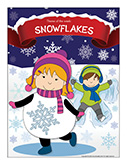
(Open weather wheel) Print, laminate, and display the wheel on a wall. Each day, name a child who will be the meteorologist. This child will be responsible for manipulating the weather wheel. As a group, determine the day’s weather and have your meteorologist place your weather wheel’s hands accordingly. On a day when it is sunny and rainy, your meteorologist can place one hand on rain and one hand on sun. Otherwise, both hands can be placed on the same illustration.
Gather several objects representing the different seasons and have children identify the correct season for each one. Ask them to identify characteristics of each season: weather, outdoor activities, means of transportation, etc.
AREA SETUP
Thematic poster-Snowflakes
(Open thematic poster-Snowflakes) Print, laminate, and decorate the walls of your daycare with all kinds of posters.
Homemade stickers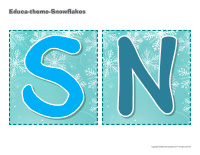
(Open stickers-Snowflakes) Print the illustrations on adhesive paper to create a variety of homemade stickers.
Educa-theme
(Open educa-theme-Snowflakes) Print and laminate. Use the different illustrations to decorate a corner of your daycare and present the theme to your group (and their parents).
Educa-decorate-Snowflakes
(Open educa-decorate-Snowflakes) Print, laminate, and cut out the various items. Use them to decorate your daycare and set the mood for the theme.
Transition games-Winter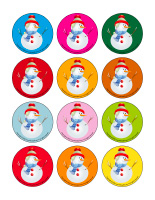
(Open transition games-Winter) Print. Let children decorate the items. Cut them out and use them to form a garland that can be hung within your daycare or near your daycare entrance.
Task chart-Snowflakes
(Open task chart-Snowflakes) Print, laminate, and display on a wall. Use adhesive putty or Velcro to add tasks to the chart. Ask children to add a check next to each task as they complete it.
Tiny hanging snowflakes
Hang several plastic snowflakes (or paper snowflakes) from your daycare ceiling. Hang posters or pictures of snowflakes on the walls.
Winter-themed tree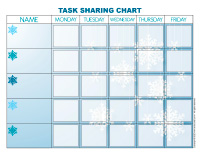
In our “Back to school” theme, we suggested installing a tree trunk with branches in your daycare to accompany your various themes throughout the year. If you prefer, you can also paint a tree trunk and branches directly on a wall or large piece of paper. To decorate your tree for this theme, add white cotton balls to represent snow on the branches.
PICTURE GAME
The picture game may be used as a memory game or to spark a conversation with the group. The pictures may also be used simply to decorate the daycare or a specific thematic corner. (Open picture game-Snowflakes) Print and laminate. Store the game in a “Ziploc” bag or in your thematic bin.
Memory game-Snowflakes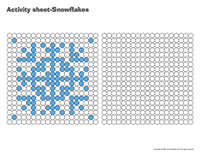
(Open picture game-Snowflakes) Print the series of illustrations twice and use them for a traditional memory game.
ACTIVITY SHEETS
Activity sheets are suggested for each theme. Print and follow instructions. (Open activity sheets-Snowflakes)
Creating a homemade activity booklet
Print and laminate several activity sheets and writing activities. Arrange them in a binder and provide dry-erase markers. Leave the binder in your manipulation area and invite children to complete the activities during free play. The use of dry-erase markers will allow you to use the booklet repeatedly.
Educa-spots-Snowflakes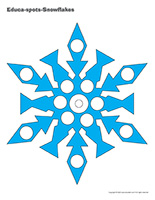
(Open educa-spots-Snowflakes) Print for each child. Use bingo markers to add color to the different circles. If you don’t have bingo markers, children can add stickers or cereal inside the circles.
Writing activities-S like snowflake
(Open writing activities-S like snowflake) Print for each child or laminate for use with a dry-erase marker.
Tracing words-Snowflakes
(Open word flashcards-Snowflakes) (Open giant word flashcards-Snowflakes) Print several word flashcards. Cut them out and glue each one on a piece of paper. Laminate them. Arrange the words in a binder and provide a dry-erase marker that children can use to trace the words. Older children will enjoy trying to write the words independently below the flashcards.
Stationery-Winter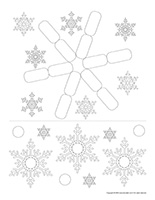
(Open stationery-Winter) Print. Use the stationery to communicate with parents, in your writing area, or even to identify your thematic bins.
Educa-nuudles-Snowflakes
(Open educa-nuudles-Snowflakes) Print for each child. Have children color the sheet and use Magic Nuudles to give it a three-dimensional look. If you don’t have Magic Nuudles, simply ask children to fill the spaces with bingo markers or stickers.
To order Magic Nuudles.
VARIOUS WORKSHOPS
Workshops-Winter
(Open workshops-Winter) Print, laminate, and display to identify your various workshops.
Workshop planning booklet-Winter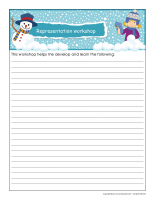
(Open workshop planning booklet-Winter) Print, laminate, and use the grid with a dry-erase marker. This essential tool will help you prepare and create the material you need for your various workshops, organize your environment, and plan per the interests of the children in your group. It will also help you analyze your weekly activities.
Workshop follow-up booklet-Winter
(Open workshop follow-up booklet-Winter) Print for each child. This booklet will help you better understand how workshops foster children’s development.
Have fun with these wonderful workshop ideas:
Construction/building blocks:
- Use only white, blue, and grey blocks if you have enough on hand.
- Create your own carpet of snow using rolls of cotton batting...or make snowy constructions.
- Sort through animal figurines and keep only the ones that live in cold climates.
- Bin filled with salt (or sugar). Let children play in it with small cars.
- Figurines that can be transformed to look like skiers or snowboarders.
- Decorate the area with posters of snowmobiles, skiers, igloos, etc.
Arts & crafts:
- A large quantity of sparkles and sparkly glue.
- Winter coloring pages.
- Construction paper, tissue paper, all kinds of papers in wintery colors (blue, white, grey).
- Salt which can be glued on dark paper.
- Chalk for drawing on dark construction paper.
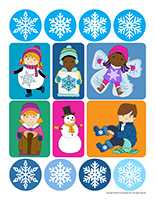
- Cotton balls can be glued to a drawing or used to make original collages.
- Models for paper snowflakes.
- Make snowflakes with waxed paper and white glue by drawing snowflakes on the paper with the glue. Allow to dry and remove gently...the result is spectacular!
- Paint with coloured ice cubes.
- Miniature marshmallows that can be used to create wintery scenes.
- Pictures of winter clothing that can be cut out and used to make a mobile.
- White paint on dark paper.
Drawing:
- Coloring pages involving snowflakes, winter scenes, winter sports.
- Snowflake stencils.
- White chalk and dark construction paper.
Role play:
- Winter clothing of all kinds...mismatched mittens, wool socks, etc.
- A pot along with bowls for making soup.
- Dishes and cups for hot chocolate.
- Decorate the area with winter scenes. You may even create a false window with its own winter scenery.
- Make your own fireplace out of cardboard and add a few logs.
Manipulation:
- Memory game with Educatall pictures.
- White, blue, or grey modeling dough...add sparkles.
- Association game for winter sports (a skate can be associated to a child who is skating).
- Puzzles related to the theme.
- Sugar cubes for building igloos.
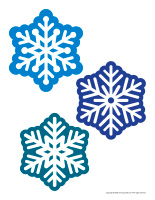
- Mini marshmallows for building snow banks and snow-covered hills.
- Stimulation bottles filled with winter objects.
Reading/relaxation:
- Books about winter with several beautiful illustrations.
- Old calendars that can be admired.
- Photo albums displaying pictures of children playing in the snow.
- Blue or white lights to create a magical atmosphere.
- Puppets and stuffed animals (polar animals, snowmen, etc.).
Pre-writing:
- Hunt and seek activities.
- Various activity sheets related to the theme.
- Games with educatall word flashcards.
- Tracing and maze activity sheets.
Motor skills:
- Snowball fight (crumpled paper).
- Build a snowman.
Sensory bins:
- Water table: add blue food coloring.
- Sugar or salt container: hide white objects in the sugar or salt, add pinecones, evergreen branches, etc.
- Real snow with mittens or gloves.
- Bin filled with ice: when it is cold enough, simply leave your bin outdoors overnight. Children can make figurines skate on the ice.
- Container filled with whipped cream, this may become a taste test.
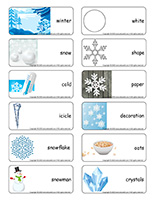
- Small container of powdered potatoes.
Science:
- Use magnifying glasses for observing snowflakes.
- Catch snowflakes on dark paper.
- Make your own birdfeeder.
- Melt ice (snow) and then refreeze the water.
- Use spray bottles filled with water and food coloring (or old marker felts) to paint on snow.
- Use thermometers to observe changes in temperature.
Kitchen:
- Various white ingredients (sugar, salt, icing sugar, flour).
- Bake a vanilla cake and top it with vanilla icing.
- Prepare whipped cream.
- Serve vanilla ice cream.
- Make homemade slushies with fruit juice.
- Experiment mixing flour and water.
- Mashed potato sculptures.
LANGUAGE ACTIVITIES
The flashcards may be used during circle time to spark a conversation with the group or in your reading and writing area. They may also be used to identify your thematic bins. (Open word flashcards-Snowflakes) (Open giant word flashcards-Snowflakes) winter, snow, cold, icicle, snowflake, snowman, white, shape, paper, decoration, oats, crystals
Let’s chat
(Open word flashcards-Snowflakes) (Open giant word flashcards-Snowflakes) Print and laminate the word flashcards. Have each child pick a flashcard and take turns presenting the item to the group. Discuss each item to see what children know about the theme.
Reinvented scrabble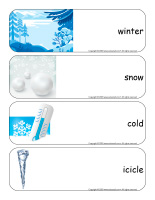
(Open word flashcards-Snowflakes) (Open giant word flashcards-Snowflakes) Print many copies of the word flashcards and encourage children to use scrabble tiles to write the words. Manipulating the small tiles represents a great fine motor skill exercise. At the same time, children will notice which letters make up the different words.
Word association-Snowflakes
(Open word flashcards-Snowflakes) (Open giant word flashcards-Snowflakes) Print two copies of several different word flashcards. On a large piece of cardboard, stick one copy of each flashcard vertically to create a word column. Cut the second copy of each word flashcard so you have the word on one side and the illustration on the other side. Attach Velcro behind each part as well as to the right of the uncut flashcards (on the cardboard). Arrange the cut flashcards on the table and encourage children to look at your flashcard board to identify a matching word and illustration. When they succeed, they may stick them next to the corresponding flashcard, on your board. This exercise will help children associate words with pictures.
Word tree-Snowflakes
(Open word flashcards-Snowflakes) (Open giant word flashcards-Snowflakes) Print several word flashcards. Use a hole-punch to make a hole at the top of each flashcard. Thread a ribbon through each hole and tie a knot. Bring the word flashcards outside and encourage children to use them to decorate a tree. Every time a child adds a flashcard, invite him/her to “read” the corresponding word. Children will be happy to repeat this activity many times. Eventually, they will learn to recognize the words.
Word clothesline
(Open word flashcards-Snowflakes) (Open giant word flashcards-Snowflakes) Print two copies of several word flashcards. Hang one copy of each word on an indoor clothesline with colourful clothespins. Arrange the copies in a pile on a table. Let children take turns picking a word and finding the matching word on the clothesline. When they find a match, they can place the flashcard on top of the one that was already hanging on the clothesline. Help younger children manipulate the clothespins if necessary.
Word race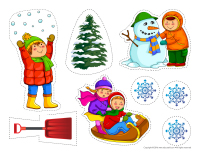
(Open word flashcards-Snowflakes) (Open giant word flashcards-Snowflakes) Print several word flashcards and hide them throughout your daycare or yard. Divide your group into two teams. When you give them the signal, children must search for the flashcards for a pre-determined period, for example three minutes. When the time is up, children must be able to “read” their flashcards to earn a point for their team. If they are unable to find the correct word, the other team can earn the point if they succeed.
Winter scene
(Open scene-Winter) Print, laminate, and cut out the pieces. Let children use the items to decorate the scene.
Sequential story-Winter
(Open sequential story-Snowman) Print and laminate the story. Cut out the illustrations and have children place them in the correct order.
Winter felt scene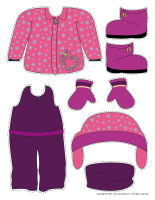
Glue four pieces of black felt on a large piece of cardboard. Hang it on the wall. Have children help you trace and cut out various felt shapes. The shapes will adhere to the black background. Children will enjoy creating many winter scenes. Change the felt shapes as your seasons and themes evolve. We have prepared models of winter shapes for you. (Open shapes-Winter)
ROUTINES AND TRANSITIONS
Steps for getting dressed-Winter
(Open steps winter clothes) Print, laminate, and stick Velcro behind each piece. Display the steps on a wall to represent a staircase, with the first clothing item children must put on at the top of the stairs and the last one at the bottom.
How to use this illustrated routine:
- First, present the tool to your group. Explain how the stairs will help them know the order in which they must put clothing items on when it’s time to go outside. Name each item together.
- To help children learn the steps, get dressed with your group. Work with one illustration at a time and remove the illustration once the step is completed. This will help children visualize what they still have to put on. Once children have acquired experience, you can leave the pictures displayed at all times.
- Look at each step with your group and have them put only the corresponding item on.
- To verify if children understand each step, invite them to explain them to you.
- Even once children can dress themselves, leave the steps displayed. They can refer to the illustrations if necessary.
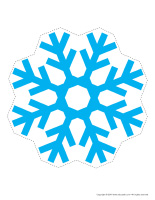
- If a child is unable to identify which step comes next, review the steps, starting with the first one. For each step, ask the child if he has put the corresponding clothing item on yet or not.
Game-This is my spot-Winter
(Open my snowflake path) Print each illustration twice. Use adhesive paper to secure one copy of each illustration on the table. Deposit the second copy of each illustration in an opaque bag and invite children to pick a card that will determine their spot at the table (corresponding illustration). The illustrations can also be used to determine children’s naptime spots or their place in the task train.
My winter path
(Open my snowflake path) Print, laminate, and use adhesive paper to stick the illustrations on the floor, creating a path that leads to various areas frequently visited by the children in your group (bathroom, cloakroom, etc.). If you prefer, you can also use the illustrations to delimit workshops or corners within your daycare.
Calling your number
Cut snowflake or snowman shapes out of white construction paper and write a number on each one. You must have two snowflakes or two snowmen bearing each number. Glue one of each on your daycare chairs. At lunch time, invite children to come pick a number to determine where they shall sit.
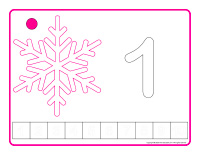
Walking through the snow
Set several construction paper snowflakes on the floor of your daycare. Invite children to hop on them in a variety of different ways: on one foot, on two feet, like a frog, etc. This is great for building gross motor skills.
Giant hopscotch game
Use white electrical tape to draw a giant hopscotch game on the floor of your daycare. If you wish, it can connect two different areas. Children will enjoy playing hopscotch as they move from one area to the other. Alternate hops on one foot and two feet. Add a winter-related illustration in each square.
PHYSICAL ACTIVITY AND MOTOR SKILLS
Modeling dough activity placemats-Snowflakes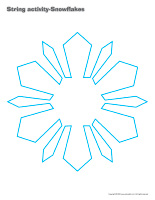
(Open modeling dough activity placemats-Snowflakes) Print and laminate. Let children pick a placemat and provide modeling dough. Encourage them to use the dough to fill or reproduce the shapes that are on their placemat.
Lacing-Snowflakes
Use a hole-punch to punch holes around the contour of a white paper plate for each child. Invite children to add eyes, a nose, and a mouth. Give each child a long piece of white or silver yarn and encourage children to thread it through the holes.
String activities-Snowflakes
(Open string activities-Snowflakes) Print for each child. Children trace the outlines with white glue before covering them with colourful string.
Bowling-Snowflakes
(Open bowling-Snowflakes) Print and use the stickers to create games. Create a bowling game with small empty plastic bottles. Press a sticker on each bottle and arrange them on a table. Children must roll a tennis ball towards the bowling pins. Give each child three tries.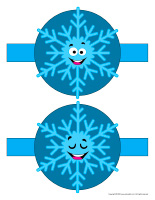
Snowflake pyramid
(Open large stickers-Snowflakes) Print and use the stickers to create games. Collect empty metal cans, making sure you have different sizes. Decorate them with stickers. Stack the cans to form a pyramid. Have children toss a frisbee towards the pyramid to make the cans fall.
Giant snowman
(Open giant snowman pieces) Print, laminate, and cut out each piece. Children sit on the floor and work together to assemble the pieces. The snowman can also be assembled on a wall and used to decorate your daycare.
String activities-Winter
(Open string activities-Winter) Print for each child. Children trace the outlines with white glue before covering them with colourful string.
Magnetic snowflakes
(Open models-small snowflakes) Print, color, and laminate the models before sticking them on magnetic paper. Leave the snowflakes on a table and provide a metal cookie sheet that children can stick them on.
Watch out for the snowman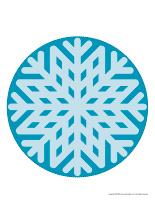
Pick a child who will become a snowman. The snowman chases the other children until he touches one. The child who is touched becomes the snowman for the next round.
Variation: You may also ask children who are touched to stop moving and hold their arms out to their sides. Children who are frozen can be saved if another child runs under their arms. Make sure each child gets to be the snowman at least once.
Big snowman
Provide a large quantity of white blocks and help children stack them to represent a snowman. Keep going until your snowman falls.
Snow-filled surprise bins
Fill a small pool or several large containers with snow and hide various objects in the snow. When you give the signal, children search for the items. Have them deposit their findings in another container before going back to search for more. When all the objects have been found, hide them again and start all over.
Igloo
Provide several cardboard boxes (white if possible) that children can use to build an igloo.
Snowflake with holes
(Open lacing-snowflake with holes) Cut the snowflake out of cardboard or heavy paper. Punch holes around the contour using a hole-punch. Have children thread ribbon or string through the holes.
Falling snow
Provide children with a blanket. Have them tear several tiny pieces of white paper and deposit them on the blanket. Each child holds one corner and makes up and down movements to make the snow dance on the blanket. When all the paper pieces have fallen off the blanket, children pick them up and start all over!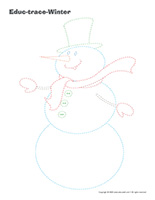
Snowstorm
In the centre of the daycare, empty several cotton ball bags on the floor. Let children have fun throwing cotton balls in the air, rolling around in them, lying down on top of them, etc. They may build snowy streets too.
The little kittens have lost their mittens
Share the story of the little kittens who lost their mittens with your group. You will need a pair of mittens for each child. Hide one mitten from each pair within your daycare. Give each child one mitten. Encourage them to search for their missing mitten. They can move about like little meowing kittens.
I am a snowflake
Children mime the following actions: tiny snowflakes gently falling to the ground, snowflakes blowing around in the wind, snowflakes being rolled into a ball, falling in the snow, jumping in snow, building a snowman, melting snow, etc. This activity can also be done during transitions.
Ice fishing
(Open models-fish) Print and have children colour the fish. Next, cut them out. Attach string to the end of an old broomstick. Hang a clothespin at the end. Hide behind furniture and attach fish to the clothespin. Children fish one at a time. You may replace fish with toys or small surprises.
Variation: Write points on the fish (for example a small fish could be worth 2 points and a large fish could be worth 5 points). Set up fishing teams. At the end of the game, calculate each team’s score to determine the winning team. This game may be played outdoors. Simply laminate the fish and hide behind a snow bank.
The skier
Set bottles in a row, leaving a certain distance between each one. Children pretend to be skiers and slalom between the bottles without tipping them over.
Speed skating
Create an obstacle course. Provide each child with two empty tissue boxes. Have them wear them on their feet and pretend to skate around the obstacles.
Dog sled race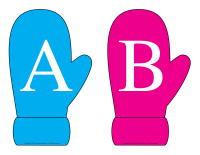
Divide the group into two teams. The object of the game is to cross the finish line before the other team. The first child in line walks on his hands with his feet resting on the second child’s shoulders. The second child also walks on his hands, and so on. The last child in line crawls.
Goalie
Deposit one hula hoop per child on the floor. If you do not have hula hoops on hand, you may draw circles. The circles must be large enough to allow children to move inside them. Give children instructions. For example, place your hands in your goal, place one foot inside your goal and one outside your goal, sit inside your goal, sit outside your goal, etc. After a while, say, “Goalies change goals.” Children change circles and the game continues.
OUTDOOR ACTIVITIES
Frozen bubbles
Blow soap bubbles outside on a cold winter day. Children will love watching the bubbles freeze in the air and then crack, like ice.
Frozen tag
Pick a child who will become a snowman. All the other children are polar animals. The snowman tries to capture the animals. Every time he touches a child, the child is frozen. He/she must remain perfectly still. The game continues until all the children are frozen. The first animal that was caught becomes the snowman for the next round.
Treasure hunt in the snow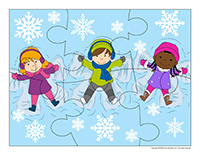
Prepare ice cubes of every colour with your group. Hide the ice cubes in the snow and have children search for them. If the group is old enough, you may ask children to find ice cubes of a specific color. For example, you may ask one child to search for blue ice cubes while another child searches for red ones. You may also ask the entire group to find only a specific colour of ice cubes.
Winter is hiding something
Choose an object with your group. Next, designate a child to hide the object in the snow and have the other children search for it. The child who finds the object gets to hide it next.
Snowball fight
Create a pyramid using empty tissue boxes. The object of the game is to make the pyramid fall to the ground by throwing snowballs on it.
Snowballs
Divide the group into two teams. Set up two baskets. The object of the game is to throw as many snowballs into your team’s basket before the time is up.
Long jump

Practice long jump in the snow.
Somersault contest
Children perform somersaults in the snow and end with original positions.
Eye of the tiger
Find white objects hidden in the snow (ping pong balls, golf balls, sheets of paper, toilet paper rolls, etc.).
MUSICAL AND RHYTHMIC ACTIVITIES
Figure skating
Play music and invite children to pretend to skate throughout the daycare. When the music stops, everyone falls to the floor. When the music starts again, they resume skating. The duration of the game is one song.
Musical winter
(Open transition games-Winter) Print, laminate, and secure the illustrations on the floor of your daycare using adhesive paper. To the sound of music, children move around the daycare. When the music stops, they must quickly find an illustration to stand on.
Wool scarf dance
Invite children to dance around the daycare, waving wool scarves to the sound of music.
COGNITIVE ACTIVITIES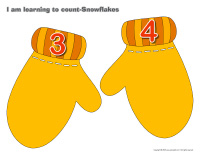
I am learning to count-Snowflakes
(Open I am learning to count-Snowflakes) Print, laminate, and display at children’s eye level. Using Velcro, children associate the correct number of snowflakes to each card.
Color by number-Snowflakes
(Open color by number-Snowflakes) Print for each child. Children must color the picture per the color code.
Educ-pattern-Snowflakes
(Open educ-pattern-Snowflakes) Print and laminate the game. Children must arrange the cards in the correct order to complete the patterns. Use adhesive putty or Velcro to press the cards in the squares.
Puzzles-Snowflakes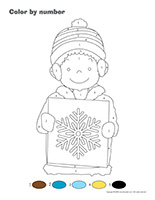
(Open puzzles-Snowflakes) Print, laminate, and cut out. Children must use the pieces to recreate the scenes.
Educa-letters-Winter
(Open educa-letters-Winter) Print and laminate each card twice and use them for a memory game. If you prefer, simply display the cards on a wall within your daycare.
Educa-symmetry-Winter
(Educa-symmetry-Winter) Print. Children must color the picture on the right to make it look exactly like the picture on the left.
Educ-trace-Winter
(Open educ-trace-Winter) Print for each child. Children must trace each line using a crayon of the corresponding color and then color the item at the end of the line.
Educ-pairs-Winter
(Open educ-pairs-Winter) Print. Children must draw a line between items that go together or color them using the same marker.
Educ-intruder-Winter
(Open educ-intruder-Winter) Print and laminate. Children must find the six items in the scene.
Winter bingo
(Open bingo-Winter) Print, laminate, and store in a small box. Play bingo with your group.
Winter
(Open poster-Seasons) Print and laminate the game. Using Velcro, children associate each pictogram to the correct season.
MORAL AND SOCIAL ACTIVITIES
Miming words
(Open word flashcards-Snowflakes) (Open giant word flashcards-Snowflakes) Print and laminate the flashcards. Deposit them in an opaque bag and use them for a mime game. Children take turns picking a word and miming it so the other children can identify the correct word. For example, if a child picks the word “scarf”, he/she can pretend to wrap a scarf around his/her neck.
Photo booth-Snowflakes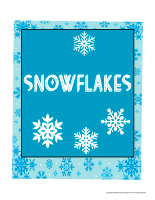
(Open photo booth-Snowflakes) Print the various accessories, cut them out, and glue a drinking straw behind each one. Purchase hats, scarves, glasses, etc. at your local dollar store. Create a wintery décor using a large piece of cardboard or curtain. Invite children to pick the accessories they prefer and pose for you. You can take individual, group, or family photos. Print the pictures and display them on a wall for everyone to see.
Igloo
Cover a table with white sheets. Deposit a bin filled with snow and winter figurines inside your “igloo”. Add books about polar animals. Children will love playing in their igloo.
Winter story and memory game
(Open story and memory game-Winter) Print, cut out, and laminate the pictures. Place the cards face down on the floor. Children pick three cards and invent a story in relation to the illustrations. Variation: Print the pictures twice and use them as a memory game.
EARLY SCIENCE
Snow
Fill a container with clean snow. Invite children to build a snow castle. Children will realize that snow melts quickly. It is transformed into water. Next, pour the water obtained from the melted snow into an aluminum pie plate. Leave it outside and show children how water becomes ice.
Winter white
Prepare a sugar, salt, flour, or rice bin. Let children play in it with figurines, small cars, etc. They will discover new textures.
Catching snowflakes
You will need a piece of black paper and a magnifying glass for each child. Prior to the activity, set the black paper in the freezer so it is very cold. Take your group outside and catch snowflakes on the black paper. Encourage children to use their magnifying glass to observe the snowflakes. What do they look like? Can they find two that are the same?
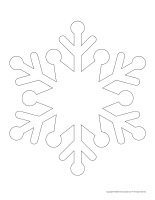
Snowstorm balloons
You will need one inflated balloon per child (no need to inflate it completely, but the surface of the balloons must be firm). Using a hole-punch, create several tiny white circles of paper. Invite children to rub their balloon on their hair to create static electricity before holding it next to the tiny circles. The paper circles will be attracted to the balloon.
Snowflake textures
Catch snowflakes with your group and provide magnifying glasses children can use to observe them. Encourage them to identify differences in terms of their texture.
ARTS & CRAFTS
Puppets-Snowflakes
(Open make your own puppets-Snowflakes) Print for each child. Have children color them and cut them out (depending on their age). When they are done, they can draw a face on their puppet and glue a Popsicle stick behind it.
My snowflake headband
Give each child a strip of construction paper. Staple or glue both ends of each strip together to form headbands. Provide several Fun Foam snowflakes that children can glue all over their headband.
Mobile-Snowflakes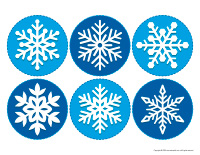
(Open mobile-Snowflakes) Print for each child. Have children color and decorate the various shapes and assemble them to create a mobile. The items can be hung from a clothing hanger, a perforated plastic container, or a paper plate.
My snowflake hat
(Open educa-decorate-Snowflakes) Print and cut out. Glue the shapes around a hat or headband.
Window decorations
You will need several clear plastic document protectors. Let children paint on them. When they are done, moisten the back of each pouch and press them on a window.
Puppets-Snowflakes
(Open puppets-Snowflakes) Print the models on heavy paper. Ask children to cut them out and decorate them with various arts & crafts materials. Glue a Popsicle stick behind the models to complete your puppets.
Models-Snowflakes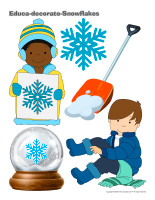
(Open models-Snowflakes) Print the models and use them for various crafts and activities throughout the theme.
Salt dough snowflakes
Provide salt dough (or modeling dough) and invite children to sculpt snowflakes. Set them out to dry and display their creations.
Giant snowflakes
Draw pairs of snowflake shapes on large pieces of cardboard. Set identical shapes one on top of the other and staple the contour, leaving the top open. Have children stuff the giant snowflakes with newspaper. When they are done, staple the top to seal the shapes. Children can paint the snowflakes.
Mosaics-Snowflakes
Cut several different snowflake-shapes out of adhesive paper and ask children to glue tissue paper, confetti, scraps of construction paper, etc. all over them. Set a second piece of adhesive paper on top and display your mosaics in a window.
Snowflake with holes
(Open lacing-snowflake with holes) Cut the snowflake out of cardboard. Punch holes around the contour using a hole-punch. Have children thread ribbon or string through the holes.
Snowman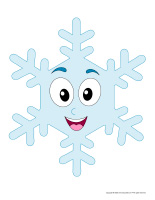
(Open craft-snowman) Print a snowman for each child. Have them colour, cut out, and glue the various snowman parts onto a piece of construction paper.
Popcorn snowman
(Open model-snowman silhouette) Print for each child. Prepare popcorn. Dip popcorn in corn syrup and stick it to the snowman silhouette. Let dry. Use fishing wire to hang.
Winter wind
Provide each child with a straw, blue poster paint, and glossy paper. Deposit a large drop of paint in the centre of the paper. Children may add sparkles of their choice. Next, with their straw, they gently blow on the paint, just like a winter wind. The paint will spread on the paper. Let dry. Children love this painting technique.
Mitten pairs
We need mittens to play in the snow. Trace children’s hands on the material of your choice and let them design original mittens.
Stormy sky
Give each child a piece of dark paper and have them draw on it with white chalk, white waxed crayons, or white wooden pencils.
Cotton ball painting
Encourage children to use cotton balls to paint on dark paper. They can simply dip the cotton balls in white paint and then press them on the paper.
Huge snowman
Collect several round objects (plate, garbage can lid, etc.). Give each child a large piece of white paper. Let them trace the items you have collected to represent a snowman. Remind them that the largest circle must be at the bottom and the smallest one at the top. When they are done, they can decorate their snowman by drawing a hat, a nose, eyes, a broom, etc.
Winter scene
Have children draw a winter scene on black construction paper using white glue. When they are done, sprinkle flour over their drawing. Shake off any excess flour over a garbage can.
Marshmallow snowman
(Open model-Snowman silhouette) Print for each child. Encourage children to fill their snowman shape with miniature marshmallows.
COLORING PAGES THEME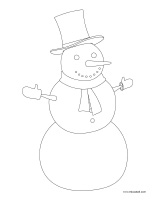
(Open coloring pages theme-Snowflakes) Print for each child.
DIFFERENT WAYS TO USE THE COLORING PAGES
Identical coloring pages-Snowflakes
Print the same coloring page for each child and an additional copy for your model. Color only certain parts of your picture. Present the model to your group and ask them to color their picture to make it look exactly like yours.
Coloring binder-Snowflakes
Print and laminate several coloring pages and arrange them in a binder with a few dry-erase markers. Leave everything on a table for children to explore.
Musical drawing-Snowflakes
Play musical drawing with your group. Give each child a coloring page. Have children sit around a table. When the music starts, they must pass the coloring pages around the table. Every time the music stops, they must color the picture in front of them until the music starts again.
Homemade puzzles-Snowflakes
Give each child a picture to color. When they are done, cut each picture into pieces to create unique puzzles.
SONGS AND RHYMES
(Open songs & rhymes-Snowflakes) Print.
Snowflakes
By: Patricia Morrison 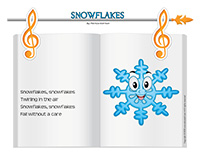
Snowflakes, snowflakes
Twirling in the air
Snowflakes, snowflakes
Fall without a care
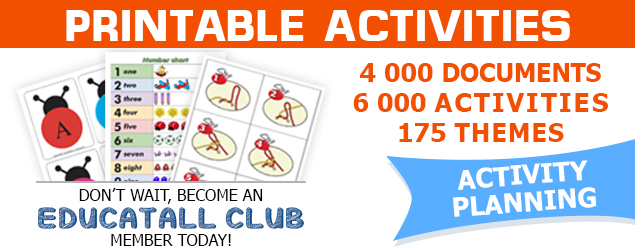
 Home
Home Theme activities
Theme activities
 Babies and toddlers
Babies and toddlers
 Arts and crafts
Arts and crafts
 Science
Science
 Creative recipes
Creative recipes
 Tips and tricks
Tips and tricks
 Special needs
Special needs
 Extra activities
Extra activities
 Educ-TV
Educ-TV
 Newsletter
Newsletter  Online store
Online store Educatall club
Educatall club


